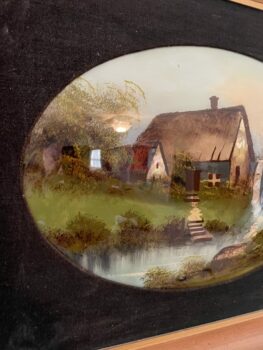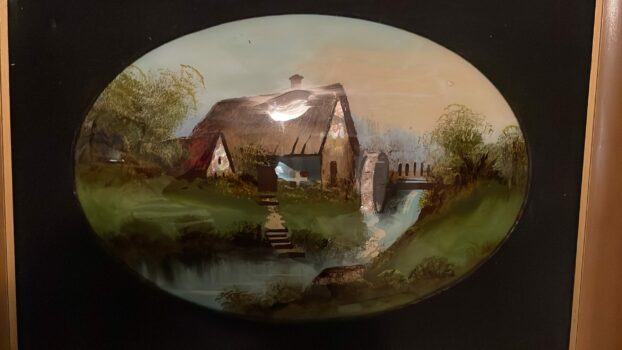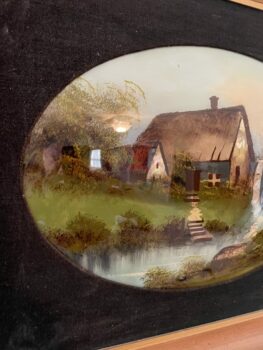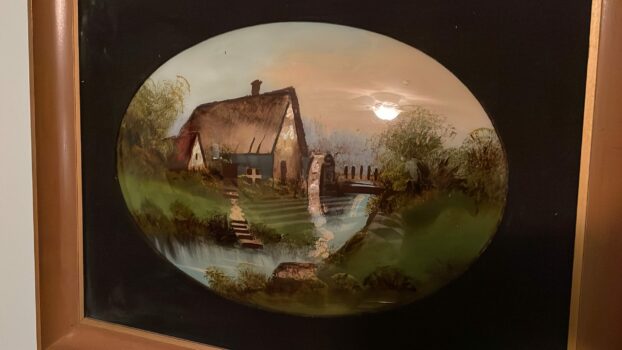This art appraisal report offers an in-depth and impartial assessment of the artwork in question, grounded in the appraiser’s expertise and familiarity with the art market. All the information and data analyzed in this report is sourced solely from the client.
Having a clear understanding of the value of your artwork is crucial in making informed decisions about its future. This report provides a precise estimate of the value of each piece, using US dollars as the base currency. It is not intended to encourage the sale of the artwork, but rather to provide valuable information on how to proceed should the client decide to do so in the future.
Detailed description of the artwork, including its medium, dimensions, and condition.
Checking Originality: Identification with Artificial Intelligence Test
In the quest to identify a match, Image Search employs advanced AI techniques to scour databases of images in order to find visually similar images. This is achieved through the use of various algorithms such as pattern recognition and machine learning. While some results may be considered as “matches” due to a clear similarity, other results may be inconclusive as they rely more on chance rather than any specific similarities. To conduct this test, a front-facing image was used as a reference to search for similar images on the internet.
The results of the automatic recognition are not conclusive. If a match is found, it will be shown below:
What specific information can we obtain from this test?
Our findings demonstrate this is a unique work of art; the comparison images in our gallery could not be matched with it. Even though there is always some uncertainty, we’ve found that this method gives accurate results 90% of the time, so it’s a good way to start figuring out if something is real. To completely identify the artwork, I continue to the next test.
Age estimation
In order to determine the age of the painting, An Original Vintage Reverse Painting on Glass from circa mid 20th Century unsigned unknown artist Convex Glass, we can examine its frame construction, color palette used, and other characteristics. The frame construction can provide clues as to the age of the painting, as styles of frames generally change over time. For instance, frames from the mid 20th century are typically more ornate and intricate than frames from earlier eras. The color palette used in the painting can also give us clues to its age. During the mid 20th century, bright and vibrant colors were often used in paintings, while earlier eras were more likely to use lighter and more muted colors. Other characteristics such as brush strokes, style of painting, and subject matter can also help us to determine the age of the painting. By examining all of these characteristics, we can get a good idea of the age of the painting, An Original Vintage Reverse Painting on Glass from circa mid 20th Century unsigned unknown artist Convex Glass.
Based on this information and the pictures provided, I can estimate this painting was made
Condition of the artwork
This original vintage reverse painting on glass, circa mid 20th century, is an unsigned work of an unknown artist. The painting, which is on convex glass, is in excellent condition and has no appreciable damages. Any existing damage is minimal and does not require restoration. This painting is a unique and beautiful piece that could be proudly displayed in any home.
Artist’s name, biographical information, artwork’s provenance (history of ownership) and exhibition history.
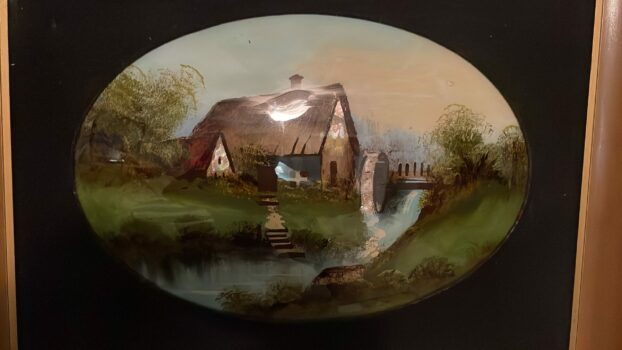
I study and research the signature of artwork to see if it matches any known signatures. At this step, I also inspect the painting’s front and back pictures, to find an artist’s name or other identifying features like stickers that may help me identify who has made this work. If there is any, provenance is also seen as an important variable because it helps figure out who the artist is.
A close picture of the signature is included in this report.
In this case, the artwork doesn’t have a visible signature. In general, convex reverse glass paintings were made for decorative purposes by unknow, local or street artists.
Detailed analysis of the artwork’s style, subject matter, and significance within the artist’s oeuvre and the broader art world.
I can check if the style and type of painting match those of the artist referenced.
This original vintage reverse painting on glass from circa mid 20th Century is a beautiful example of the traditional art form. The unsigned, unknown artist has created a stunning piece with its convex glass, vibrant colors, and delicate brushstrokes. The attention to detail is evident in the intricate patterns and textures that have been carefully crafted to bring the painting to life. The scene depicted is timeless, capturing the essence of the era and the artist's unique style. This painting is a true work of art, a unique and beautiful representation of the artist's talent.
Comparable sales information, including prices realized at recent auctions or private sales of similar works by the artist or in the same medium.
. In order to provide an up-to-date estimate of the fair market value for the original vintage reverse painting on glass from circa mid 20th century, unsigned, unknown artist convex glass, I utilized the data collected, including auction prices and other relevant market information. This is crucial as it can be used in various contexts such as insurance, estate planning, and art market analysis, allowing us to determine how the value of the artwork may have shifted due to the changing environment and economic landscape. It also offers a valuable insight into how the valuation of the artwork may have changed due to environmental or economic factors.
The auction prices were a significant factor in determining the current market value of the artwork, as they are based on actual transactions between buyers and sellers in the art market. As such, they are a strong indicator of the expected value of the piece in the near future.
By analyzing auction results from the last 6 months, I was able to accurately determine the current fair market value of the artwork. This approach provides a comprehensive view of how the value has changed over time and gives insight into any potential areas of appreciation or depreciation in its price. Additionally, it allows me to adjust my valuation as new auction prices become available.
Conclusion
Investing in art can be a great way to diversify a portfolio and tap into the potential for significant returns. Art can provide a tangible asset for the investor, and it is also an appreciating asset. As the demand for artwork increases, the value of a piece of artwork can increase significantly. Furthermore, investing in art can provide an emotional return as well as a financial one. Art can be an expression of the investor's personal style, and can bring joy to the investor when they look at it. Buying a piece of artwork can be a great investment and can provide a unique and lasting return.
This painting can be considered valuable by the art market because it is an original, vintage piece from the mid 20th century and it is rendered on a rare and unique medium of convex glass. The fact that it is unsigned and by an unknown artist also adds to its value, as it is likely to be a one-of-a-kind piece.
Final Appraisal Value ($)
500-600$
Appraisal Report made by:
Andrés Gómez
BSc, MSc, Expert Art Appraiser
10+ years of experience in Online Art Appraisals
100k+ Customers Served
Antique Store Owner
You can check my portofolio of past appraisals here:
https://www.appraisily.com/andres-portofolio/

Relevant photographs or supporting documentation, such as condition reports or expert opinions
A detailed summary of the appraisal process and the appraiser’s qualifications.
Mark-to-market art appraisal is a vital method for determining the current value of a piece of artwork. This form of valuation requires an appraiser to consider various factors, such as market conditions, the condition and age of the artwork, and the artist’s reputation. By taking all these elements into account, a mark-to-market art appraisal delivers an accurate assessment of a piece of artwork’s current market value.
The artist’s reputation, as determined by their track record in gallery and museum shows, awards, and other accomplishments, is also considered in mark-to-market art appraisal. Appraisers use this information to determine if the value of a piece is likely to increase or decrease over time. Additionally, they will inspect the condition of the artwork and note any signs of wear or damage that might affect its future resale value.
When performing mark-to-market art appraisals, appraisers also consider market conditions by researching current art market trends and comparable works that have recently sold. This information is used to provide an estimate of a piece’s worth at that point in time. By considering all of these factors, mark-to-market art appraisal is able to give a reliable indication of the current value of a work. This kind of valuation can also ensure fair prices are paid and received when buying or selling art.
In summary, mark-to-market art appraisal is a crucial tool for determining the true value of a piece of artwork, enabling buyers, sellers, and appraisers to make informed decisions regarding its worth. It takes into account multiple aspects to provide an accurate assessment of the current market value of a work. This information can be used to ensure that buyers and sellers are getting a fair price for the artwork, and that the appraiser’s valuation is up-to-date and reflective of current market conditions.
In the case of insurance replacement appraisals, mark-to-market art appraisals can also be used to accurately estimate the cost of replacing a lost or damaged artwork. The current value, as determined by the appraisal, is then used to determine the amount that the insurance company will pay back to the policyholder. This way, policyholders can rest assured that they will receive an appropriate sum for any artwork that needs to be replaced due to accidental damage or theft. Additionally, this kind of valuation helps insurers ensure they are not being overcharged when artwork needs to be replaced as part of a claim settlement.
The appraisal process is a thorough evaluation of the item or items in question. It involves researching and analyzing the information provided by the requester in order to provide an accurate estimate of its value. The appraiser takes into account factors such as condition, rarity, demand, and market prices. Photographs and detailed descriptions are especially important when providing an appraisal, since they help the appraiser identify any potential flaws or defects that could affect the item’s worth. By using all the resources that are available, an evaluation can be done quickly, efficiently, and with a high level of accuracy.
A statement of the appraiser’s liability and any potential conflicts of interest.
A qualified art appraisal, also known as a formal written evaluation, is a professional assessment of the monetary value of a piece of art by an individual who has specialized knowledge, expertise, and training in the field of art appraisal. This person must meet certain educational and professional requirements, including experience in researching and evaluating art, as well as knowledge of the art market and current market trends. The purpose of a qualified art appraisal is to provide an objective and unbiased opinion of the value of a piece of art for various purposes, including insurance claims, tax planning, estate planning, or to help determine a fair price for a sale or purchase.
We are committed to providing our clients with the most accurate and unbiased appraisal reports. To ensure impartiality, we adopt a flat rate, fixed fee structure for all appraisals, instead of a percentage-based fee. This eliminates any potential conflicts of interest between the art appraiser and the final report value. Our appraisal reports are in compliance with the Appraisal Foundation’s USPAP (Uniform Standards of Professional Appraisal Practice) standards and guidelines, which are widely accepted as the ethical and performance standards for appraisers. This guarantees that our reports are of high quality and legally defensible.
How to sell this artwork.
We have a structured guide to help you sell your artwork, you can find it here.
